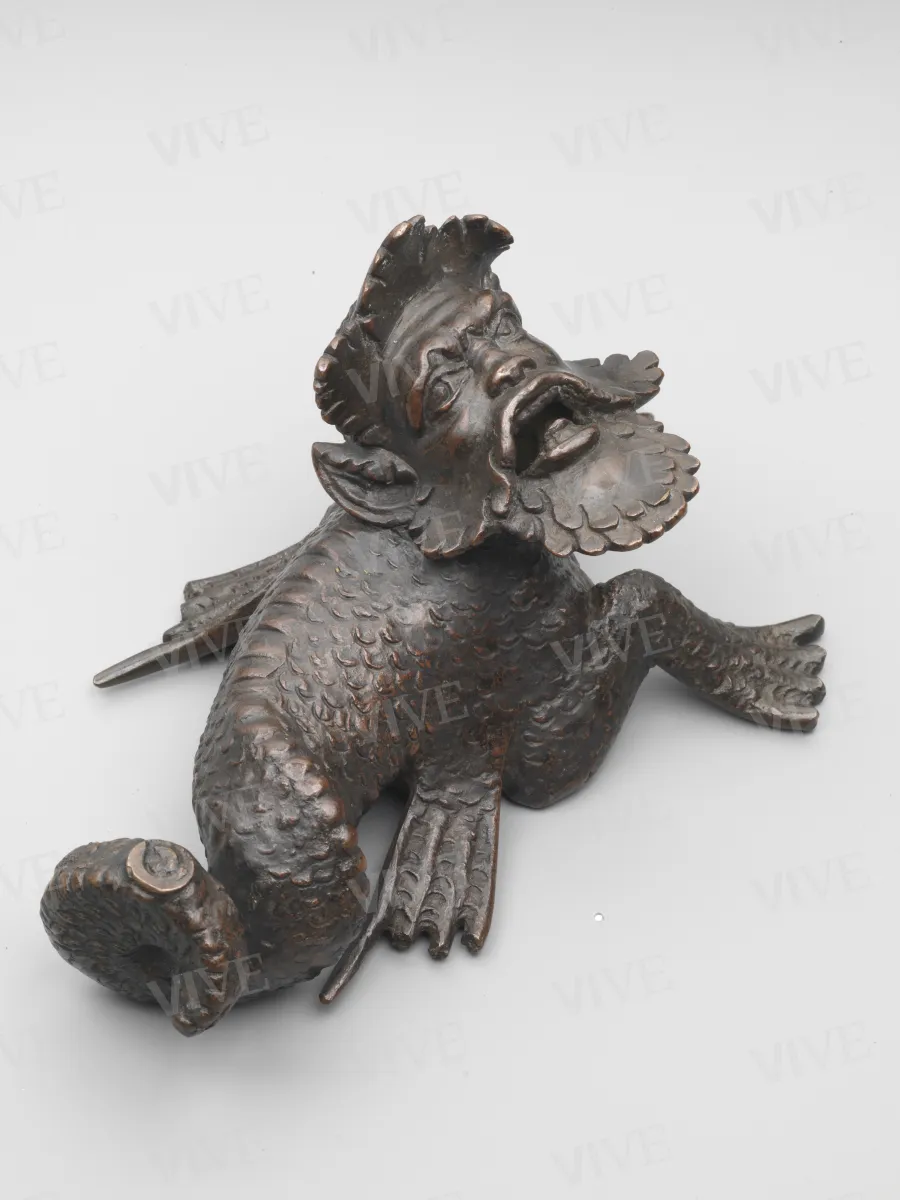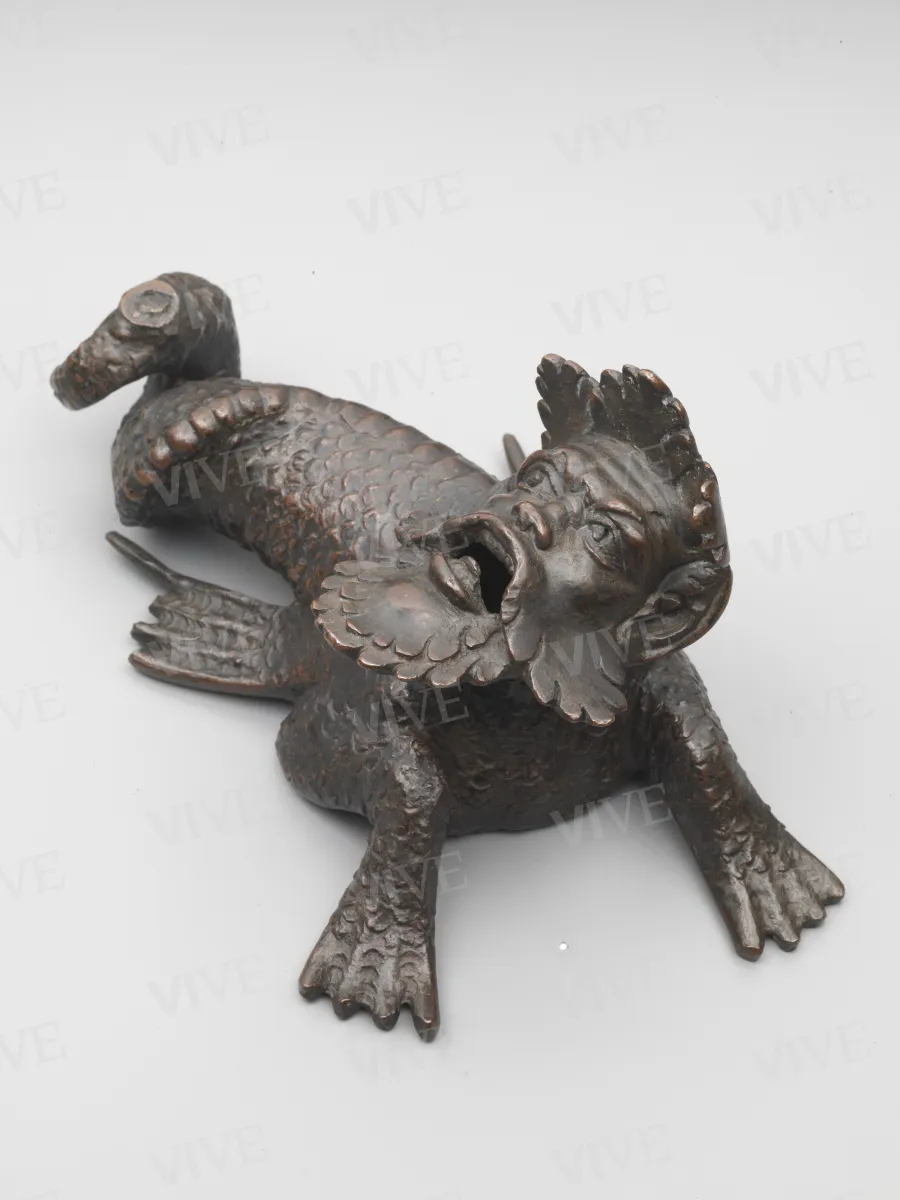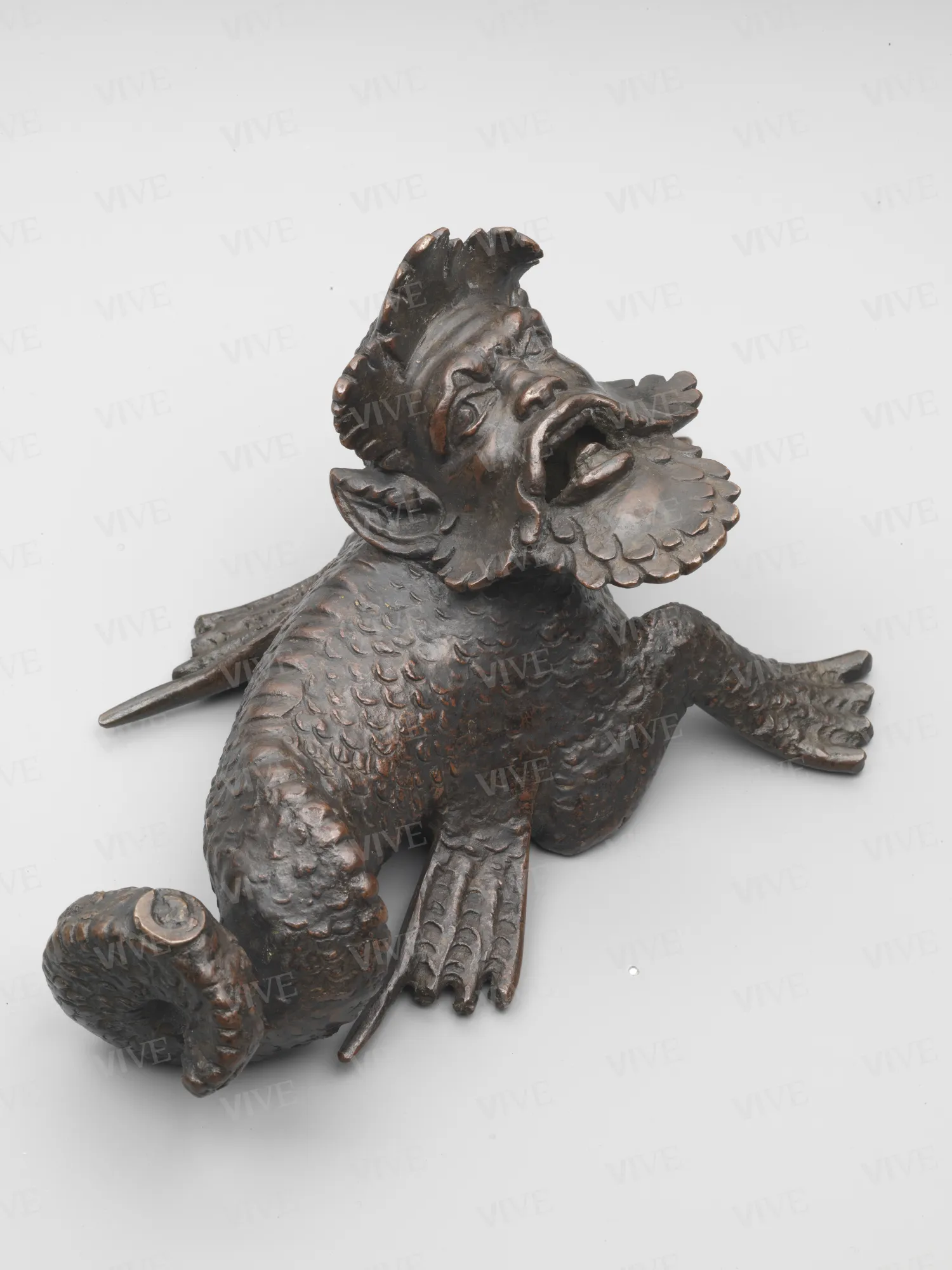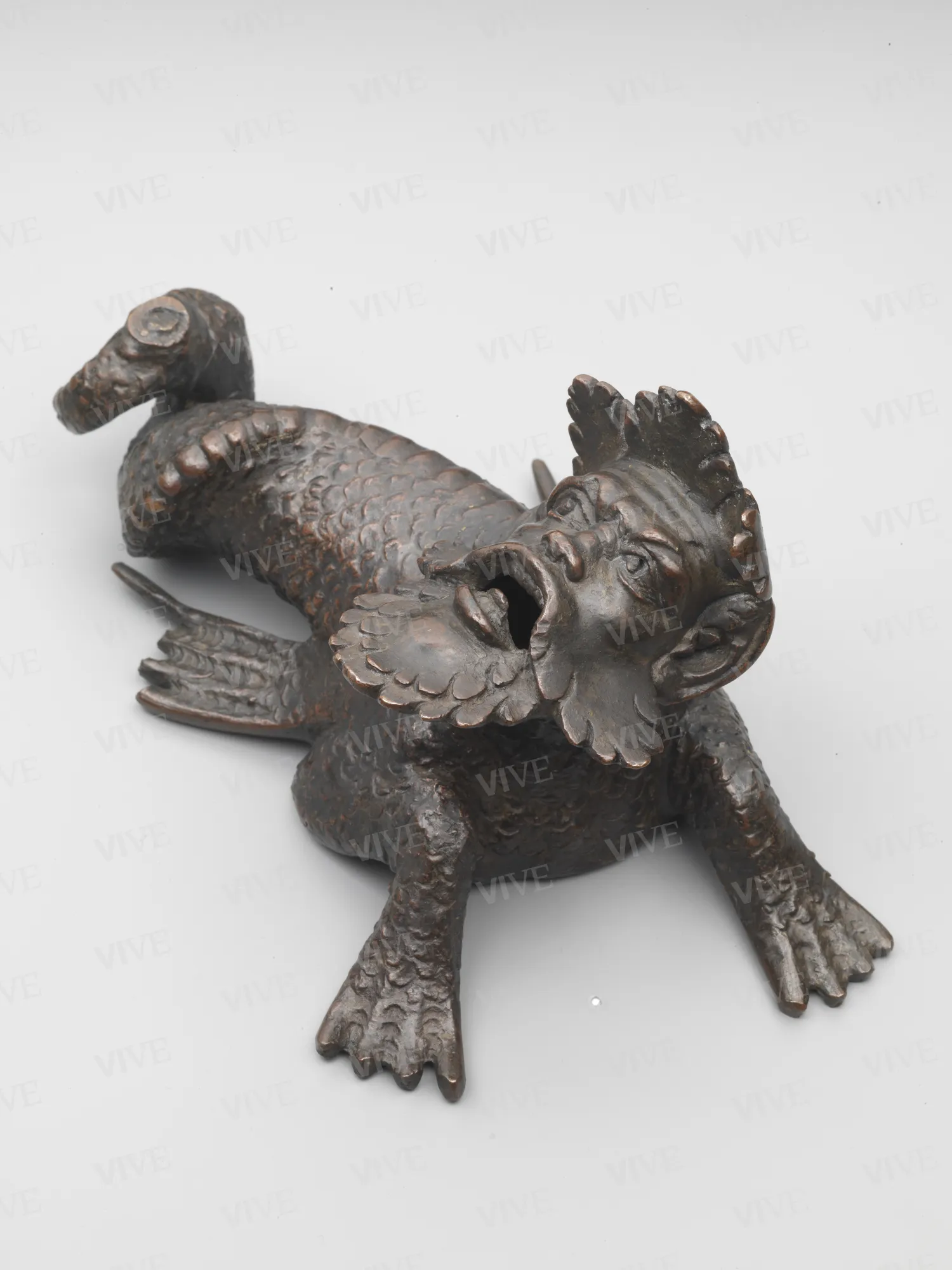Sea monster
Workshop of Severo Calzetta da Ravenna 1510–1530 (the model)
The creature with a humanoid face and a body covered in scales is likely a pistrix, an entity commonly depicted alongside Greek and Roman sea deities. In numerous extant examples of this small bronze sculpture, the figure of Neptune, which was originally attached to the animal's tail to complete the composition, has been preserved. The initial design of this group was created by Severo da Ravenna, a renowned bronze artist from the Veneto Renaissance. However, this particular specimen was cast in his workshop, which continued producing replicas of the master’s models well into the sixteenth century.
The creature with a humanoid face and a body covered in scales is likely a pistrix, an entity commonly depicted alongside Greek and Roman sea deities. In numerous extant examples of this small bronze sculpture, the figure of Neptune, which was originally attached to the animal's tail to complete the composition, has been preserved. The initial design of this group was created by Severo da Ravenna, a renowned bronze artist from the Veneto Renaissance. However, this particular specimen was cast in his workshop, which continued producing replicas of the master’s models well into the sixteenth century.
Details of work
Catalog entry
This formidable creature, potentially identifiable as a pistrix—a mythical animal often associated with sea deities in Greek and Roman mythology—is portrayed with a human face, its beard and hair substituted by acanthus leaves and elongated pointed ears. The body is entirely encrusted with scales, the front legs are webbed, powerful fins emerge from the hips, and the tail, which is truncated at the end, coils around itself (Pollak 1922, n. 23, 38; Santangelo 1954, 35; Cannata 2011, 62–63, cat. 60). The monster exhibits a frowning and sorrowful expression, its mouth open and tongue protruding, while its gaze is directed upwards as if addressing another figure. In some of the many known examples of this small bronze sculpture, the figure of Neptune affixed to the animal’s tail has also been preserved.
In 1907, Wilhelm Bode credited Bartolomeo Bellano with the creation of this type, depicting the god of the seas standing on the pistrix (Bode 1907, I, 22). However, twenty years later, Leo Planiscig contested this attribution and identified similar figures of Neptune and sea monsters in various collections and museums. He attributed these works to a single artist, whom he provisionally named “Meister des Drachens” (Planiscig 1927, 105–113). In 1935, Planiscig further identified another comparable sea monster—now housed in the Frick Collection—with the inscription “O.SEVERI.RA,” identifying it as the signature of Severo Calzetta da Ravenna. This artist was documented both in Padua and his hometown, and was mentioned by Pomponio Gaurico in 1504 as one of the preeminent sculptors of his era (Planiscig 1935, 80–82; Gaurico 1999, 254).
In addition to addressing questions of attribution, research has also examined issues related to chronology, the influence of other artists, and seriality. For instance, Patrick De Winter has identified references in various depictions of the sea monster to both the sorrowful face of the Vatican Laocoön and Mantegna’s engraving illustrating the battle of the sea gods (De Winter 1986, 94–96).
Dylan Smith has recently classified the works attributed to Severo into four distinct groups based on technological evidence, distributed over time. He specifically attributes Neptune on the sea monster type to the third group, dated to between 1510 and 1530 and known for almost entirely hollow, technically superior works. Regarding the female figure, more than thirty comparable examples have been identified. According to Smith's classification, the example housed in the Museo di Palazzo Venezia can be grouped with those from the National Gallery in Washington and the Museo Arqueológico Nacional in Madrid. This grouping is characterized by figures with less human-like features, higher crowns, and more spiral-shaped tails (Smith 2008, 49–80).
The earliest depictions of Neptune on a sea creature were likely created by Severo to meet the demands of the Mantua court. According to the inventories of Isabella d’Este and Federico II Gonzaga’s estates, there are items described as “a Neptune on a monster with a trident” and “two small metal figures of Neptune with a trident and a sea monster under his feet” (Warren 2001, 156 cat. 32). Calzetta chose to replicate his original design using indirect casting techniques to produce similar items, thereby converting a sophisticated study piece into an everyday object. This nearly “industrial” production persisted beyond the master's death, with his heirs continuing to use his models and making new adaptations to cater to various clients (Avery, Radcliffe 1983, 107–121).
Marco Scansani
Entry published on 12 June 2025
State of conservation
Fair.
Provenance
Rome, Collezione Alfredo Barsanti, 1934;
Rome, Museo Nazionale di Palazzo Venezia, 1934.
References
Bode Wilhelm, Die italienischen Bronzestatuetten der Renaissance, 3 voll., Berlin 1907;
Pollak Ludwig, Raccolta Alfredo Barsanti, Roma 1922;
Planiscig Leo, Andrea Riccio, Wien 1927;
Planiscig Leo, Severo da Ravenna: der “Meister des Drachens”, in «Jahrbuch der Kunsthistorischen Sammlungen in Wien», XLV, 1935, pp. 75-86;
Santangelo Antonino (a cura di), Museo di Palazzo Venezia. Catalogo delle sculture, Roma 1954;
Avery Charles, Radcliffe Anthony, Severo Calzetta da Ravenna: New Discoveries, in Rasmussen Jörg (a cura di), Studien zum europäischen Kunsthandwerk, München 1983, pp. 107-122;
De Winter Patrick, Recent Accessions of Italian Renaissance Decorative Arts, Incorporating Notes on the Sculptor Severo da Ravenna, in «The Bulletin of the Cleveland Museum of Art», LXXIII, 1986, pp. 75-138;
Gaurico Pomponio, De sculptura, a cura di Cutolo Paolo, Napoli 1999;
Warren, in De Vincenti Monica, Gastaldi Elisabetta (a cura di), Donatello e il suo tempo: il bronzetto a Padova nel Quattrocento e nel Cinquecento, catalogo della mostra (Padova, Museo Civico, 8 aprile-15 luglio 2001), Milano 2001;
Smith Dylan, I bronzi di Severo da Ravenna: un approccio tecnologico per la cronologia, in Ceriana Matteo, Avery Victoria (a cura di), L’industria artistica del bronzo del Rinascimento a Venezia e nell’Italia settentrionale, Atti del convegno (Venezia, 23-24 ottobre 2007), Verona 2008, pp. 49-80;
Cannata Pietro, Museo Nazionale del Palazzo di Venezia. Sculture in bronzo, Roma 2011.














